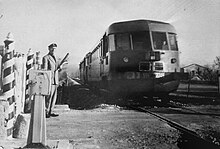Littorina (railway)
Littorina refers to the entirety of light rolling stock with thermal power drive (diesel, gasoline or gas) on all gauges both in the Italian railway network and in railway networks that were largely created under Italian influence.
The word apparently comes from the years between 1932 and 1933, when Benito Mussolini drove to the town of Littoria, better known today as the Latina , in one of these vehicles .
In the beginning was the designation for vehicles of the series ALn 56 , ALn 556 and ALn 772 . As a result, this name has been retained in Italian colloquial language, while the use of the word automotrice ( drive vehicle ) has established itself in administrative language.
Colloquially, the name was then expanded to include all light rolling stock , apart from the drive force ( heat engine or, albeit less, electric drive ).
In Milan , some drive cars in service in the interurban tram network from the OMS and OEFT series are also called Littorine .
The first Littorine
The first Littorine had the drive, the clutch system , the power transmission and the wooden seats without toilets in common with buses .
Classification of the drive car
The Littorine of the FS (Italian State Railways) are marked with a series like ALx XXX XXXX. The abbreviation AL stands for Automotrice Leggera (light railcar).
literature
- Automotrici termiche . Firenze, Ferrovie dello Stato, 1971.
- Nico Molino: Littorina . Salò, 1991.
- Nico Molino, Sergio Pautasso: Le automotrici della prima generazione . Torino, 1983. ISBN 88-7649-016-7


